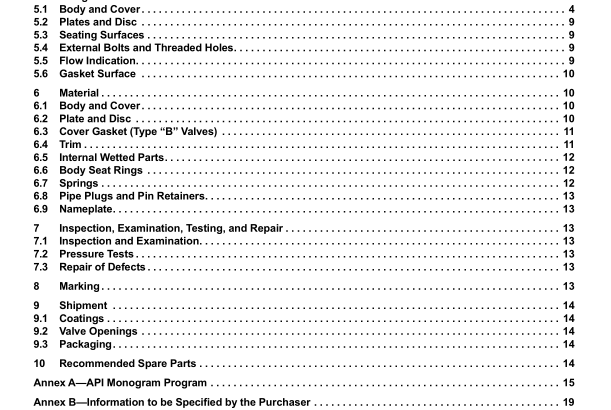API 594:2017 pdf free download.Check Valves: Flanged, Lug, Wafer,and Butt-welding
— Type “A” and Type “B” valves: Steel, nickel-alloy, and other alloy valves shall be finished as specified in ASME B16.5 and ASME B16.47 Series A.
5.1.7 Auxiliary connections are required only when specified by the purchaser:
— Type “A” gray iron and ductile iron valves: The size, type, and location of auxiliary connections shall be the manufacturer’s standard unless otherwise agreed by the manufacturer and the purchaser.
— Type “A” steel, nickel-alloy, and other alloy valves: Auxiliary connections shall comply with the requirements of ASME B16.34. The location and designation of auxiliary connections shall be the manufacturer’s standard.
— Type “B” valves: For steel, nickel-alloy, and other alloy valves, auxiliary connections shall comply with the requirements of ASME B16.34. The location and designation of auxiliary connections shall be per ASME B16.34.
5.1.8 The valve may have either an integral or a removable seat ring. Sealing compounds or greases shall not be used when assembling seat rings; however, a light lubricant having a viscosity no greater than kerosene may be used to prevent galling of mating threaded surfaces.
5.1.9 Tapped test openings are permitted only if specified in the purchase order. If a tap is made in the body for testing the valve, the tap shall not be larger than DN 15 (NPS 1 / 2 ). After testing, the tapped hole shall be fitted with an ASME B16.1 1 or ASME B16.14 threaded solid round or hex-head plug. The test tap shall comply with ASME B16.34. 5.1.10 For Type “A” valves, a tapped blind hole shall be provided in the body of valves that are either NPS 10 or larger, or which weigh more than 23 kg (50 lb), for attachment of an eye bolt or equivalent lifting device. The hole shall be tapped with a coarse (UNC) Class 2B thread, conforming to ASME B1.1 . If an eyebolt is specified in the purchase order, it shall conform to ASME B18.15.
5.1.11 Unless otherwise specified in the purchase order, for Type “A” valves, the lugs of lu -type valves and flanges of double-flanged type valves shall be provided with non-threaded (drilled) bolt clearance holes.
5.1.12 Butt-welding ends shall conform to the requirements of ASME B16.25 for the bore specified for use without backing rings.
5.1.13 Conversion of a flanged end to a butt-welding end is not permitted, except by agreement between the purchaser and manufacturer.
5.1.14 Type “B” valves shall have a bolted flat or dished cover design that meets the requirements of ASME BPVC, Section VIII-Division1 . Cover and cover flanges shall be circular, except DN 50 and DN 65 (NPS 2 and NPS 2 1 / 2 ) may be of noncircular design. Body-to-cover joints shall be flanged with a flat face (Class 150 only), raised face, tongue and groove, spigot and recess, or ring joint based on ASME B1 6.5 and ASME B16.47.
5.1.15 The body-to-cover joint of Type “B” valves shall have at least four through type bolts of the following minimum sizes:
— M10 or 3 / 8 in. when 50 ≤ DN ≤ 65 (2 ≤ NPS ≤ 2 1 / 2 );
— M12 or 1 / 2 in. when 80 ≤ DN ≤ 200 (3 ≤ NPS ≤ 8);
— M16 or 5 / 8 in. when DN ≥ 250 (NPS ≥ 10)
The total cross-sectional area of the bolts shall be in accordance with the requirements of ASME B16.34. 5.1.16 When valve design utilizes a stem that extends beyond the pressure boundary, stem retention shall be in accordance with ASME B1 6.34. The design shall not rely on actuation components (e.g. gear operators, actuators, levers, etc.) to prevent ejection.
5.1.17 Type “B” swing check valves shall be equipped with a single-contact stop point to prevent the possibility of the disc getting stuck in the open position.
5.2 Plates and Disc
5.2.1 Valves are classified as follows:
— A single-plate valve has a plate or disc that closes the valve when flow reversal or gravity forces the plate or disc against the valve-body seat. This closure may be aided by the use of springs or other devices.
— A dual-plate valve has plates that close the valve with the assistance of one or more springs when flow reversal forces the plates against the valve-body seat.API 594 pdf download.API 594:2017 pdf free download
